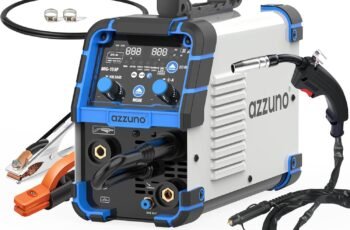Ad Blocker Detected
Our website is made possible by displaying online advertisements to our visitors. Please consider supporting us by disabling your ad blocker.
You’ve encountered the frustration of common MIG welding machine issues, like inconsistent wire feed and excessive spatter, disrupting your projects. With some simple adjustments and maintenance, you can tackle these problems effectively. By optimizing wire feed speed and maintaining the liner, you improve weld quality. Don’t forget to check voltage and ensure proper gas flow for stability. Curious about more solutions to elevate your welding game? There’s much more to explore.
Ensuring Proper Gas Flow and Shielding
Proper gas flow and shielding in MIG welding are crucial for achieving high-quality welds. You need to ensure your regulator is set to the right pressure, as this controls the gas flow consistency. Inspect your hoses regularly to catch any leaks or blockages that can compromise shielding. The torch nozzle must direct the gas effectively onto the weld pool; make sure it’s clean and free from spatter. Inadequate shielding gas coverage is a major factor that can lead to issues such as porosity, where gas is trapped in the weld metal. Check for leaks at the regulator, hoses, or torch connections, as these can introduce atmospheric contamination, causing porosity. Always use the correct gas mix and nozzle size for your application. Keep the nozzle 0.25–0.5 inches from the workpiece and shield your work area from drafts to maintain effective coverage. These steps help prevent common welding issues.
Optimizing Wire Feed Speed and Liner Maintenance
While optimizing wire feed speed and maintaining your liner, you must ensure the efficiency and quality of your MIG welding process.
Start by setting your wire feed speed according to material needs—150–250 ipm for ½” steel or 450–600 ipm for 1/8” aluminum. Test on scrap metal first to avoid surprises. Proper wire feed speed ensures consistent weld quality and minimal defects. Listen for a steady “sizzling bacon” sound for optimal settings. If the arc pops or hisses, adjust speed or voltage accordingly.
Regularly inspect and clean liners, replacing them every 50–100 hours, and ensure drive rolls match wire diameter to prevent feed issues.
Use compressed air weekly for cleaning. Properly lubricate bearing surfaces and align wire guides to minimize friction and maintain consistency.
Controlling Voltage and Ensuring Proper Penetration
After fine-tuning wire feed speed and maintaining your liner, it’s time to focus on voltage control to ensure proper penetration in your MIG welding projects.
Voltage determines arc length and heat input, directly affecting penetration and weld bead shape. Too low, and you risk incomplete fusion; too high, and burn-through becomes a problem. Adjust voltage based on material thickness—thicker metals need more voltage. It’s crucial to note that the ideal voltage/wire speed combination can significantly enhance weld quality, producing strong, clean welds with minimal spatter.
Keep stickout distance under 10mm to maintain arc efficiency. Align polarity with your shielding gas and wire type; positive polarity boosts penetration but increases spatter.
If penetration issues arise, check voltage and wire speed settings. Ensure your adjustments are consistent to avoid hot spots or cold areas, using scrap metal for testing.
Adjusting Gun Angle and Travel Speed for Optimal Results
Achieving optimal results in MIG welding often hinges on how you adjust the gun angle and travel speed. You should split the included angle for joints; for a 90° joint, use a 45° work angle. In overhead welding, maintain a 5–15° travel angle to control the molten metal. Choose push or drag angles based on joint type and material, keeping a 0–10° deviation from perpendicular. Proper ergonomics, such as using a MIG welding gun with a locking trigger, can prevent repetitive stress injuries that hinder welding performance. Manage travel speed to prevent burn-through on thin materials and excessive bead width on thick ones. For thicker materials, increase speed to avoid puddle collapse. Consistency in speed helps achieve uniform beads. Adjust angles and speeds according to material thickness to balance penetration and heat input effectively, ensuring even heat distribution and minimizing porosity.
Identifying and Preventing Spatter Causes
Understanding the root causes of spatter in MIG welding is crucial to improving weld quality and efficiency. Begin by checking your amperage and voltage settings. High settings can cause aggressive wire feeding, leading to spatter. Also, ensure your wire feed speed is aligned; incorrect speeds result in arc instability. Use the right transfer mode—opt for short-arc or spray transfer to reduce spatter. Don’t ignore spool guns for thin wires to maintain a stable feed.
Material preparation matters too. Clean base metals thoroughly to prevent contaminants from disrupting the arc. Protective surface layers, such as zinc or aluminum oxide, should be removed as they can contribute to spatter issues and affect weldability.
Address shielding gas issues by maintaining proper CO₂ ratios and flow rates. Lastly, use high-quality consumables; inconsistent wire diameters and damaged tips can increase spatter. Adjust your technique to suit the material and position.
Maintaining Nozzle and Tip for Consistent Performance
Proper maintenance of the nozzle and tip is vital for ensuring consistent performance in MIG welding. Replace contact tips every 10–15 hours and nozzles every 25–30 hours to avoid arc inconsistency and poor weld quality.
Look for signs of wear like uneven weld beads or visible damage. Regularly inspect and clean using wire brushing and anti-spatter gels to prevent buildup.
Store them in original packaging, in a dry environment, and handle with gloves to avoid contamination and damage. Adjust wire speed and gas flow rates to reduce wear, and check wire tension to prevent fusing.
Post-cleaning, inspect gas flow integrity to ensure optimal performance. Proper care extends the lifespan of your consumables and enhances welding quality.
Addressing Common Welding Machine Issues
When facing welding machine issues, a systematic approach can quickly restore performance and quality.
First, address gas flow inadequacies by checking the flow rate (25–40 CFH), inspecting hoses for leaks, and ensuring proper nozzle size. Prevent draft interference by blocking air intrusion, and keep an eye on gas reserves to avoid disruptions.
Next, tackle lack of fusion by maintaining a gun angle of 0–15°, adjusting travel speed, and ensuring sufficient heat input. Monitor parameter alignment by balancing voltage and wire feed speed to prevent defects.
Lastly, manage material prep by cleaning surfaces, drying moisture, and pre-heating thick materials. These steps will help you maintain a stable welding process and produce high-quality welds consistently.
Conclusion
To wrap up, tackling common MIG welding issues is all about proactive maintenance and adjustments. Ensure proper gas flow to reduce spatter, and match wire feed speed with your material. Clean or replace the liner to prevent blockages, and adjust voltage for better arc stability. Keep your gun angle and travel speed steady for consistent welds. Regularly check and maintain the nozzle and tip. By following these steps, you’ll enhance your welding quality and efficiency.



